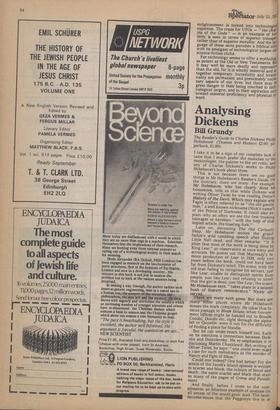Analysing Dickens
Bill Grundy
The Reader's Guide to Charles Dickens Philip Hobsbaum (Thames and Hudson £2.00; paperback, E1.00).
I take it to be a sign of my complete lack of taste that I much prefer the musician to the musicologist, the painter to the art critic, and any of Charles Dickens's works to Philip Hobsbaum's book about them.
This is not because there are no good things in Mr Hobsbaum's Reader's Guide. On the contrary, there are many. For example. Mr Hobsbaum, who has clearly done his homework, tells us that while Dickens was writing Oliver Twist he was reading Defoe's History of the Devil. Which may explain whY Fagin is often referred to as "the old gentleman," a well known nickname (Nick's name?) of the Prince of Darkness. It could also explain why so often we see the Jew cooking sausages or saveloys "with the help of that impish article, the toasting-fork."
Later on, discussing The Old Curiosity Shop, Mr Hobsbaum quotes the grandfather's wild rambling speech after finding Little Nell dead, and then remarks: "It is plain that most of the work is being done by King Lear," an observation at once witty and accurate. He points out that Macready's famous production of Lear in 1838, only two years before the book, could not have been far from Dickens's mind. The scene, with the old man failing to recognise his servant, just like Lear; unable to distinguish spirits from people, just like Lear; and refusing to admit that the girl is dead, just like Lear; the scene., Mr Hobsbaum says, "takes place in a solemn hush of literary reminiscence." Nicely observed.
There are many such gems. But there are .many other places where Mr Hobsbaurn misses the mark completely. He takes that famous passage in Bleak House, when Government offices might be handed out to Boodle, Coodle, Doodle etc, right through the alphabet to Quoodle, were it not for the difficulty of finding a place for Noodle.
But he can under-reach himself too. Early on he mentions a connection between Dickens and Dostoievsky. He re-emphasises it in discussing Martin Chuzzlewit. But, writing of Oliver Twist, he says: "one could even make a case for such melodrama as the murder of Nancy and fight of Sikes."
Could one indeed? One had better! For the whole of the Jacob's Island episode is written in scarlet and black, the colours of blood and death; the same scarlet and black that stain so many of the pages of Crime and Punishment.
And finally, before I come to the compliments, an hilarious example of analysis (in all senses of the word) gone mad. The boatbecome-house that the Peggottys live in at Yarmouth "is best thought of as a womb."
You had never thought of it that way? But of course you did! It's small, it's cosy, it's warm. And since it is a boat-on-land it has the security of terra firma, with associations of salt water or "amniotic fluid." Got it now? And there are other things. For example, the Peggottys possess a tea-tray "showing a mother taking a child (evidently a boy) out for a walk; father is in evidence only as a Phallic symbol, her parasol, and the boy is trundling a hoop reminiscent of the female genital organ." There is much more, but the best is the analysis of David's bedroom in the boat-become-house-become-womb. The bedroom is described as desirable, so " here is a grown man recollecting sexual desire." There IS a window where the rudder used to go _through; that is clearly "partly sadistic."
rhere is a looking-glass framed with oyster
shells " narcissistic," Mr Hobsbaum says brieflY. And there is, of course, " a little bed, Yvhich there was just enough room to fit Into," as David describes it. That's sadistic !oo, in case you were wondering. But excesses like that are mercifully rare, and if you can forget them, or even skip them, the book has a great deal to offer. It deals With all the novels, of course, but it also deals With all the sketches, scenes, characters, and tales which Dickens wrote, not — as one tends to forget — just as a young man, but throughout the whole of his working life. And the book makes clear just how working that life Was — reporter, novelist, editor, actor, Polemicist, father, son, and a whole host of Other things. Why then did I feel a slight sense of impatience with it? Mr Hobsbaum provides a clue as early as page 12, where he talks of the structure of the book being comprised of a complex of plots and strands (which he defines). If, and presumably only if, all these Work together, towards what Mr Hobsbaum calls the theme,' then the book has succeeded.
But many of the novels are unarguably successes, even when this hasn't happened, especially when some character gets out of hand tarld develops a life of its own — irrelevant Life, I suppose Dr Leavis would call it, al',,Dough not irrelevant to me. When Dickens eMbarks on one of those 'hallucinatory flights, as Mr Hobsbaum calls them, where his characters take on that life of theirs, they do not seem to me the indication of a flagging, in his' rational imagination,' but as the bursting of its banks by whatever particular creat-. ive urge was flooding up inside him.
Mr Hobsbaum clearly loves and reveres Dickens, but he seems sometimes to forget that the author was great enough to make his oWn rules as he wanted and to break them When he wanted. That, I imagine, is wliat genius is all about.































 Previous page
Previous page